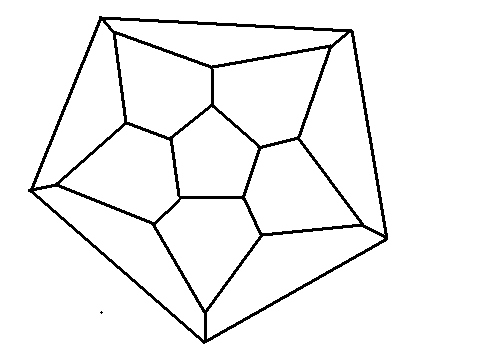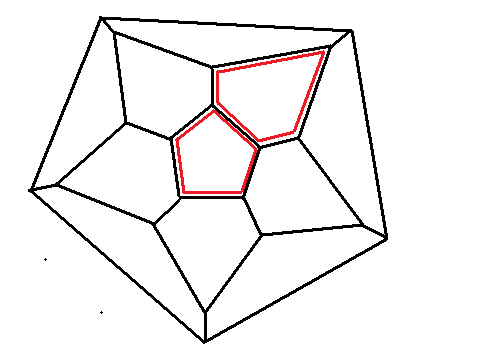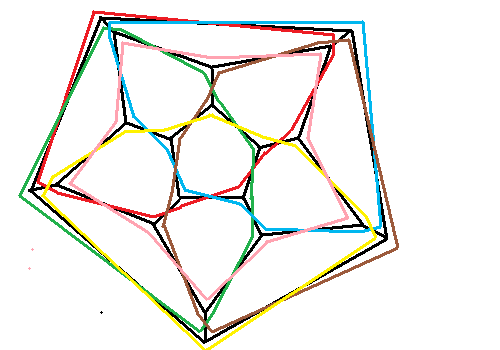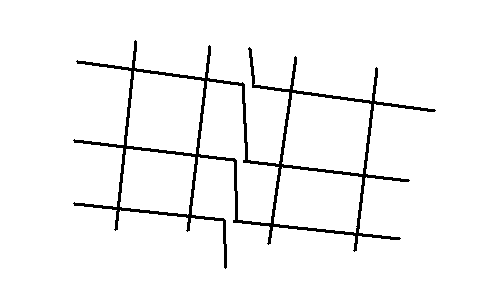The decorative knots to be discussed here are those which are tied with one or more cords that may be repeated through several plies. These sorts of knots can be represented by self-intersecting loops on the plane, set up so that no more than two loops intersect at any single point. One generates a tying diagram from such by picking which of the two paths are uppermost at each intersection point. While this could be done more arbitrarily, for the knots discussed here the paths will be selected so that each path alternates over and under as in:

My eventual objective here is to tie a knot with approximate dodecahedral or icosahedral symmetry. Let’s begin with a line drawing that has the right symmetry. Flattened out to the plane, the dodecahedron looks like the following planar graph:

But this is not in the form we need; it is not in the form of a collection of loops. The basic problem is that, as a graph, there are three edges meeting at each vertex.
There are ways of transforming diagrams so that the symmetry is retained. The reader is probably familiar Euler’s formula for planar graphs: V + F – E = 2 where the letters stand for the numbers of vertices, faces, and edges. If a triple (V,F,E) satisfies this relation, then so does (F,V,E). That is, Euclid’s formula allows the existence of a graph with the number of vertices and faces swapped. And in fact, just this can be done. At the center of each face, define a new vertex and draw edges from these vertices to other vertices if the old figure had an edge between the corresponding faces. The result will be that each vertex will be transformed to a face, each face will be transformed to a vertex, and the edges will be spun around. This duality transformation converts a dodecahedron into an icosahedron:

where the outer edges of the icosahedron need to be a bit broken. Unfortunately, this is also not in the form of a knot. The vertices of the icosahedron have 5 edges meeting; we need instead 4.
There is a transformation that will take an arbitrary graph and turn it into a knot. We need to replace each edge with two edges. The trivial way to do this is as follows:

But this isn’t much of a knot; it falls apart. Instead, we may make progress by replacing each edge with two edges with a crossing. The result is that each edge is doubled so E’ <= 2E, each vertex becomes a face and the old faces are kept so that F’ <= F+V, and each edge becomes a vertex so V’ <= E. Computing, we have V’ + F’ – E’ = (E) + (F+V) – (2E) = V + F – E = 2. Drawing over the black dodecahedron with colored lines, we find that there are six loops:

If a graph is in solid form, such as the edges of an icosahedron, and is regular enough, the above transformation can be obtained by cutting the vertices back to the centers of the edges. That is, the above modified icosahedron graph is also the edge graph of an icosahedron modified by a dodecahedron, the icosidodecahedron.
The tying diagram for the Monkey’s fist is built from 3 loops. One ties this with a single line by diverting the line from one loop to another after each loop has been traced an appropriate number of times (the usual is 3). The result is a knot with cubic symmetry. One could use the same method to tie a knot with icoshedral symmetry. There would be 40 crossings, so it’s a fairly complicated knot.
Another way of modifying a knot is to draw a line parallel to an already existing line. When the existing line is in the form of a loop, this can be thought of as splitting a loop into two. This can be repeated. Suppose we take all the loops of a knot and split them into four or five loops each. The result will be that each intersection (or vertex or crossing) will a square array of crossings. These regions will become cross hatches. Note that a square field of cross hatches has no contribution to Euler’s formula as each square has one face, four 1/4 vertices, and four half edges so the change in V+F-E is zero. In this sense, rectangles meeting four at a corner are flat.
Since Euclid’s formula gives V+F-E = 2, there has to be regions of the knot that contribute nonzero to this formula. For icosahedral symmetry in a knot, the natural way to arrange for this is to have 12 pentagons and 20 triangles. That is, the contribution to vertices from each pentagonal face will be 5/4 as the vertex is shared by 4 faces; the contribution to edges is 5/2. Similarly, the number of vertices from each triangle is 3/4 and the edge contribution is 3/2. The contribution from 12 pentagons is (12) + (12×5/4)-(12×5/2) = -3, while the contribution from 20 triangles is (20) + (20×3/4) – (20×3/2) = 5. Thus, as expected, a knot with overall approximate icosahedral symmetry will need 12 pentagons and 20 triangles.
Another basic topological operation that can be done on a knot, cutting and gluing. In order to preserve the flatness and/or approximate symmetry of the knot, this can be done by shifting the cut ends by one. if the cut and paste is made across quadrilaterals, then the cut will conveniently preserve the shape of the cut pieces, that is, the cut and paste will transform quadrilaterals to quadrilaterals:

Now if we split a loop, the result will be two loops separated by a series of quadrilaterals. Therefore, combining these two transforms is a way of changing the connectivity of a knot while keeping the number and types of shapes the same.
So. Here’s the challenge. Begin with the icosidodecahedron. It requires 6 loops. Duplicate each loop it now needs 12. Consider cuts between loops. Is there a way of choosing these so that the resulting knot becomes a single loop knot? If there is more than one way, what is the most elegant? And can any of them be tied as a Turk’s Head, that is, in a simple repetitive manner on a cylinder?

I like the graphs of the monkey’s paw — translation of one art into another.
Here’s another little present, a guide to cats for engineers:
I like isocahedrons, buckyballs are truncated versions. They are such beautiful things aren’t they? BTW I dedicated a post to you. Thanks:)
[Carl: This showed up in my spam buffer, but I deleted all the spam so I can’t tell who it’s from. Ooops.]
Mr. Brannen:
I come here for the view of knots from an elevated plane, you trick
me into staying for presentations in math and physics / cosmology
that I normally wouldn’t click on. The math and some of the science
is above my training or grasp but the logic and exposition makes them
a pleasure to read as well as educational. I admire your skill and
envy any future students or aids in your coming endeavors.
William Elliott
That’s very nice, William. I’ll try and write more intermediate articles.
Carl
P.S. Any relation to Robert Elliott, the executioner?